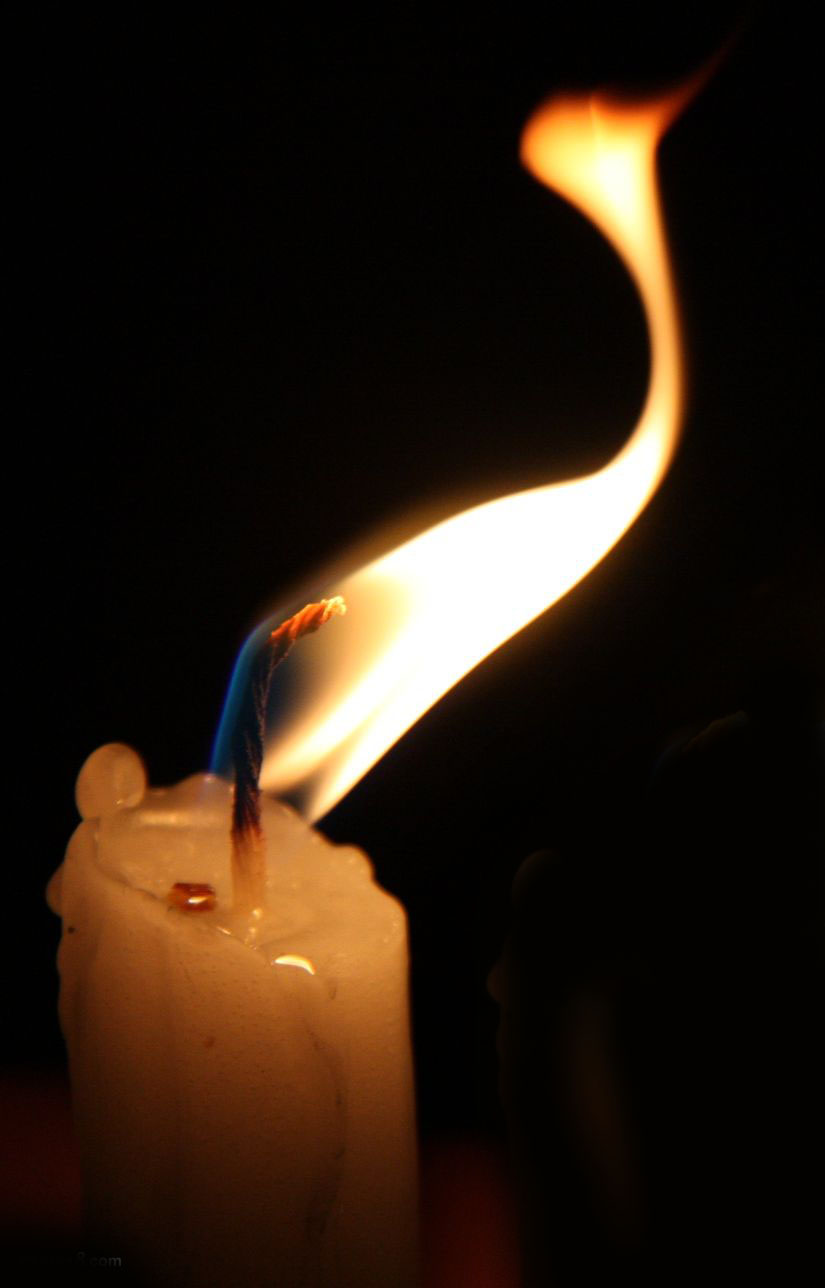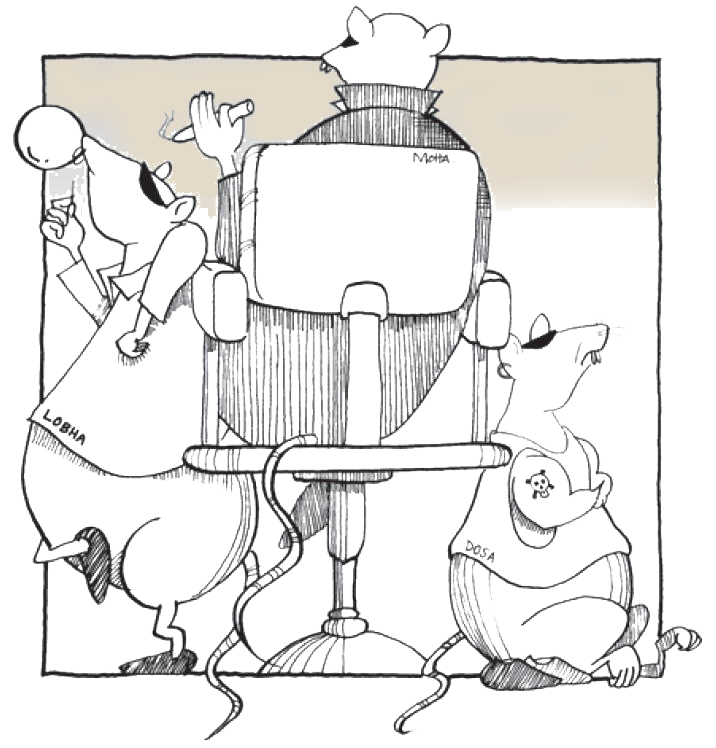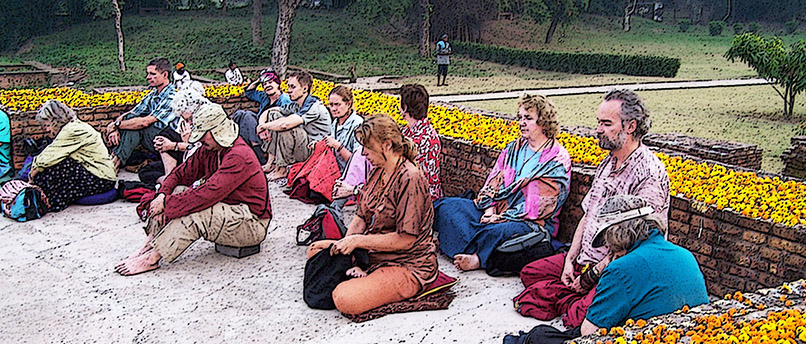
Others in this series: Mediation As Wisdom and Kindness * . . . * The Mind Needs a Job * Beginning the Journey
You cannot control the mind
and observe it at the same time.
When I was nine years old, I entered a cave for the first time. While vacationing with my family, a park ranger led us three-quarters of a mile into a mountain. We reached a deep chamber where spotlights shined on benches and railings. The rest of the chamber disappeared into darkness. “Take a seat or hold onto a rail,” the ranger advised. “I’m going to turn the lights out.”
When she did, my eyes couldn’t adjust to the dark because there was no light to adjust to.

She turned on a powerful four-cell flashlight that lit a tiny circle on the ceiling. I could make out the texture of rock. Then she shined it on a crack in a wall. She moved the light to three or four other places. The intensity of the beam was impressive. But I only saw tiny fragments of the cavern. The effect was not satisfying.
She turned the flashlight off and lit a single candle. The modest flame glowed in all directions filling the entire cavern with a soft glow: I could see the people, stalactites and stalagmites, magical rock formations, a river flowing through, and the expanse of the cavern. It was beautiful and inspiring.
Different styles of meditation have different objectives: some develop the mind-heart like a flashlight beam, some like a candle flame.
The Buddha’s first teachers trained him to focus like a ray of light. He entered states of rapture and tranquility. He mastered one-pointedness beyond any of his contemporaries. But when he relaxed, old neuroses popped back up like bamboo raft that had been held underwater.
“This doesn’t work,” he realized. “Concentration produces peacefulness. But it doesn’t last.”
So rather than focus like a beam of light he let his mind glow like a candle flame. Within a few weeks, he woke up. An open, receptive awareness brought him freedom, ease, and wisdom. And they didn’t leave him for the remainder of his life.
This was the meditation the Buddha taught. We could call it mettapanna or “kindness and wisdom meditation,” or more simply “easing awake.”
This is the second talk in a series giving an overview of this practice. In it we’ll (1) compare one-pointed to open awareness, (2) look at the cause of the disturbances in the mind, and (3) examine these in our own awareness. We’ll start with the focused mind.
The ability to zero in can be very useful. It helps us cope with emergencies, solve problems, and get things done. We use it to examine the cupboard and refrigerator to make a shopping list that insures we get what we need. We can be thankful for the ability to focus.
The other day my wife told me one of the toilets wasn’t working. I jiggled the handle and listened intently. The tank was not filling.
I studied the mechanism inside: water levels carried a donut-shaped float up and down a plastic stalk. When the water receded, the float slid down the stalk until it turned a little water spigot on. When the water flowed in, it lifted the float until it turns the spigot off.
I reasoned our float was not falling and rising properly. I felt the stalk: it was encrusted with crystals from the minerals in the water. I used a table knife to scrape the crystals off. Problem solved!
Throughout the process, my attention was centered and on task. It helped me diagnose the problem and find a solution. I was glad for that concentrated awareness.
But sometimes I want more from life than shopping efficiently or fixing a broken toilet. I want to thrive, not just handle problems; I want to be enriched, not just get by; I want deep wellbeing, not just task efficiency; I want to know the breadth of life, not just how to analyze minutia. For this I need a mind-heart that is more like a candle flame glowing in all directions.


The Buddha was a master teacher of this wise, open, receptivity.
It requires patience. At first the mind flickers. It sputters on and off and dances around dimly, like a small flame in a drafty cavern. We’re tempted to clamp down on the mind, to hold it still, to force it to sit down and shut up. These efforts are usually counter-productive. They may bring a little peace for a short time. But in the long run, forcing the mind to do anything is exhausting and agitating.
The drafts are caused by us running around flapping our arms. Rather than being upset and scurrying hither and yon, we can watch the flame with peaceful fascination.
As we relax, the breezes subside and the flame becomes steady and bright. In deep meditation, it becomes luminous – brighter than the brightest beam of light but without the harshness. Everything becomes self-illuminating.

To say this differently, imagine a pond covered with choppy waves. We want to jump in and slap the waves into stillness. But this would create more disturbances. So we sit patiently. Gradually, the waves run out of energy and quiet themselves. In time the water is clear enough to reveal its depths and still enough to reflect the forest and sky without distortion. This tranquility is more profound because we didn’t create it: we just allowed it.
To allow this quiet, it helps to know where the drafts in the cave or waves on the pond come from. If we know their source, our natural wisdom knows what to do. What are these disturbances? What is their essence?
They are tension. That’s all: the stresses and strains of life. They are flows of energy passing through our neural networks. They are swaths of tightness running through the mind-heart. Sometimes they are subtle ripples. Sometimes they are squirrels on caffeine or coyotes howling at the moon: sometimes the mind has more enthusiasm than it knows what to do with. But the mind is innocent in that it means no harm. It just responds to natural forces.
Yet these drafts and waves cause the mind to flicker. They disturb natural clarity. They distort perception. They prevent us from seeing how things truly are. Any time the mind or body are less than fully relaxed, awareness becomes a flickering candle or choppy wave.
The distortions can be so subtle or familiar that we may not recognize the tension in them. Here are some examples. Notice the contraction in each of these thoughts:
Traditionally there are three categories of tension:
With a little mindfulness, it’s easy to see the tension in desire and aversion. There’s also tension in spacing out. It’s a quiet static. We don’t see it because… well … because we’re spaced out.
Imagine running through an airport carrying a suitcase. Your hand becomes numb. It’s filled with tension but you don’t notice it because you’re focused on getting to the boarding ramp.
However, when you stop and pay attention, you notice your hand hurts. You didn’t know that a moment before. But now there’s a deep aching. As you feel it, the fingers relax naturally. Clear awareness is enough for them to soften on their own.
This is a clue to how to work with disturbances in meditation: relaxed awareness is often enough for the tension to release and the distortions to abate on their own.

The traditional term for distortion is “defilement.” But in English, “defilement” can imply a moral failing. Yet distortions arise naturally out of our neural wiring. It’s how we’re built.
Evolutionary forces rewarded those who went after things that helped them survive (like food or mates), avoided things that threatened their survival (like predators or bodily damage), and ignored things that weren’t relevant to survival or procreation. They lived a little longer and passed their DNA on to us. These latent tendencies are now wired into us.
There’s no need to be hard on ourselves for attractions, aversions, and cloudiness. It’s not a moral issue or personal failing. It’s just what the mind does.
Yet our deepest wellbeing is grounded in knowing the truth of how things really are. So undistorted awareness is essential to happiness. It’s called “waking up” and seeing what’s actually here.
So effective meditation cultivates awareness that is relaxed, undistorted, and attentive.
Let’s shift from these metaphors and explanations to our experience of awareness.
Place your attention in your feet. Feel where they press against the floor and other sensations …
Now move your awareness to your hands. Perhaps you feel your fingers holding the page or touching the desk next to your computer or resting on your lap…
Shine the light of awareness on your belly. Can you feel it rise and fall with each breath? …
Shift attention to the realm of sounds: perhaps sounds from the room or sounds of birds or cars outside. See what you notice…
These are examples of focused attention. All these experiences have two things in common: an object of awareness and awareness itself. They require both. Without feet, you wouldn’t have sensations. Without the movement of the breath, you won’t feel the belly rise and fall.
But these experiences wouldn’t occur without awareness. Perhaps you weren’t aware of your feet before I made the suggestion. Your feet were here, but your attention was elsewhere.
In effective meditation, the awareness is more important than the object of awareness. We can meditate with any object. But we can’t meditate without awareness.
Try this:
Relax. Don’t focus on anything specific. Just notice where attention goes. It may gravitate to a physical sensation, a sound, a thought. See where it goes without trying to control it …
After a while, it naturally moves to something else. Don’t hang onto the old object or latch onto the new. Let it move where it will …
Now, notice awareness itself. How does it feel? Is it tight or loose, clear or foggy, light or heavy? None of these qualities are good or bad. They just happen to be here for now. Notice without judgment or preference …
This is awareness of awareness. This is the heart of advanced meditation. This is the path to true awakening.
Awareness of awareness is difficult in the beginning because the mind is designed to look outside itself. Awareness is not as tangible as a mantra or feel of the breath rising and falling. So some people begin meditating with an external object or a tangible sensation. But as awareness gets stronger, it naturally turns to see itself. We start to be aware of awareness. This is an important shift. *
As meditation deepens, we find the quiet mind is not a cold void. As thinking shuts down, it is not like stepping into a gigantic deepfreeze with the lights turned off.
The quiet mind sees clearly without judging. In human terms we call this “love” – seeing what is and accepting things as they are.
The quiet mind is also intelligent. Without distracting thoughts, it sees more keenly.
The quiet mind is luminous: a candle flame illuminating a vast space. As we experience this more intimately, it seems strangely familiar – like an old friend we knew a long time ago. We suspect it’s been here all along quietly and unpretentiously infusing everything.
When the busy, active, swirling aspects of the mind reassert themselves, the quiet glow seems to fade. But we know it’s still there. It’s been here all along. We know it will always be here.
And knowing this makes all the difference.
We shall not cease from exploration
And the end of all exploring
Will be to arrive where we started
And know the place for the first time.

_________
Others in this series: Mediation As Wisdom and Kindness * . . . * The Mind Needs a Job * Beginning the Journey
Copyright 2013 by Doug Kraft
This document is licensed under a Creative Commons Attribution-NonCommercial 4.0 International License. You are welcome to use all or part of it for non-commercial purposes as long as you credit the author. Specific licensing details are here.
How to cite this document
(a suggested style): "Meditation as an Inner Glow" by Doug Kraft, www.dougkraft.com/?p=InnerGlow.